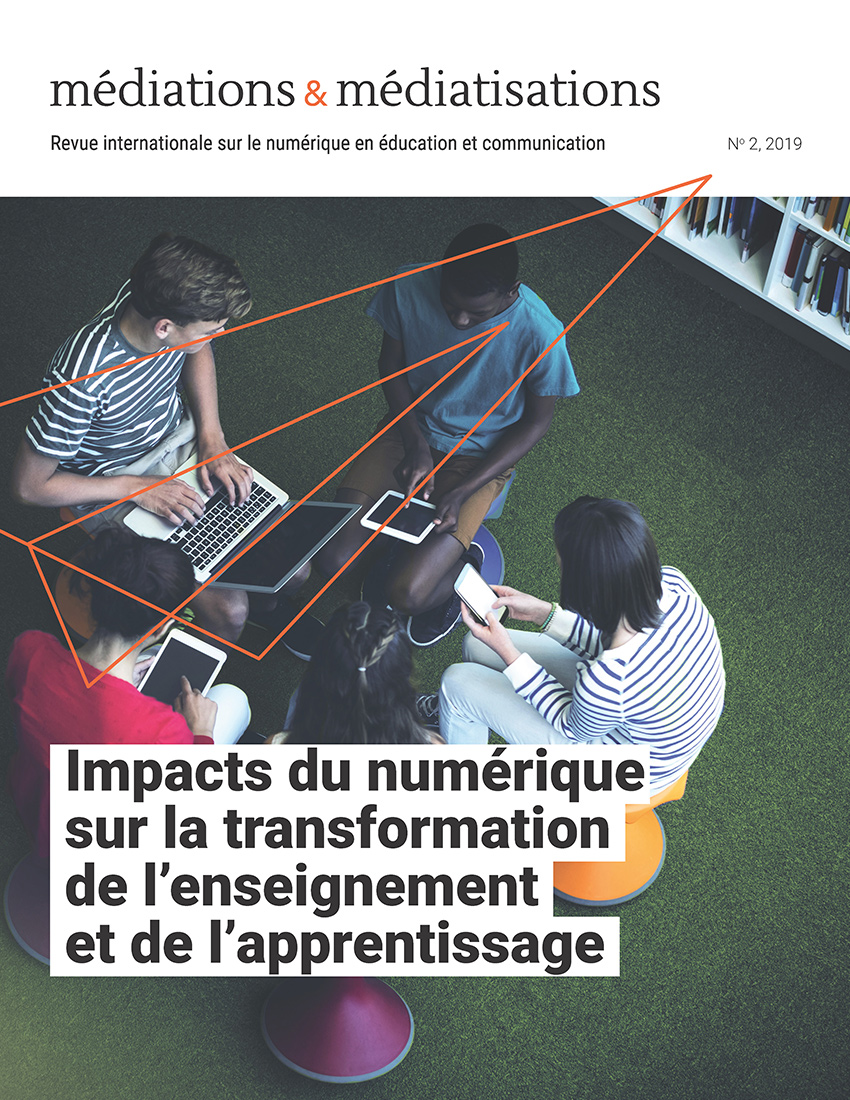Partage d'informations contextuelles via l'apprentissage à distance asynchrone: Aperçus d'un projet de recherche contextuel dans les écoles primaires
Contenu principal de l'article
Résumé
Cet article présente l’implantation de plateformes de collaboration à des fins de recherche dans les établissements d'enseignement primaire. Dans notre étude, Edmodo a été introduit comme média pour faciliter les discours asynchrones entre des apprenants de la Guadeloupe et du Québec. L'analyse suivante est basée sur les traces numériques issues d'une activité en ligne entre des apprenants travaillant sur deux projets de recherche de deux disciplines différentes : l’un en linguistique et l’autre en éducation pour le développement durable (EDD). Cet article traite essentiellement de la procédure d’introduction d’un outil de collaboration à des fins éducatives à un public possédant des compétences diverses en matière de compréhension et d’utilisation. En outre, il fournit une analyse conceptuelle pour comprendre le contenu des messages échangés en ligne au cours de ces interactions liées au contexte.
Téléchargements
Renseignements sur l'article

Cette œuvre est sous licence Creative Commons Attribution - Pas d'Utilisation Commerciale - Partage dans les Mêmes Conditions 4.0 International.
Références
Adam, F. & Westlund, H. (2013). Innovation in socio-cultural context. New York: Routledge. Bales, R. F. (1950). Interaction Process Analysis. Cambridge. MA: Addison-Wesley.
Chou, C. C. (2002). A Comparative Content Analysis of Student Interaction in Synchronous and Asynchronous Learning Networks. Proceedings of the 35th Annual Hawaii International Conference on System Sciences, https://doi.org/10.1109/hicss.2002.994093
Corno, L. & Mandinach, E.B. (1983, 06). The role of cognitive engagement in classroom learning and motivation. Educational Psychologist, 18(2), 88-108. https://doi.org/10.1080/00461528309529266
Davis, F. D., Bagozzi, R. P. & Warshaw, P. R. (1989). User Acceptance of Computer Technology: A Comparison of Two Theoretical Models. Management Science, 35(8), 982–1003. https://doi.org/10.1287/mnsc.35.8.982
Depover, C. (2014). Quels modèles économiques et pédagogiques pour les MOOC? Distances et médiations des savoirs. Distance and Mediation of Knowledge, 2(5).
Dillenbourg, P. (1999). What do you mean by collaborative learning? In: P. Dillenbourg, (ed.), Collaborative Learning: Cognitive and Computational Approaches (p. 1-19). Oxford: Elsevier.
Erlin, B., Yusof, N. & Rahman, A.A. (2008). Integrating Content Analysis and Social Network Analysis for analyzing Asynchronous Discussion Forum. Presented at the 2008 International Symposium on Information Technology, IEEE. https://doi.org/10.1109/itsim.2008.4631996
Forissier, T., Bourdeau, J. & Psyché, V. (2018). Quand les contextes se comparent et se parlent. Contextes et Didactiques, 10, 111-122.
Garrison, D. R., Anderson, T. & Archer, W. (1999). Critical Inquiry in a Text-Based Environment: Computer Conferencing in Higher Education. The Internet and Higher Education, 2(2-3), 87–105. https://doi.org/10.1016/S1096-7516(00)00016-6
Garrison, D. R. & Anderson, T. (2003). E-Learning in the 21st century: A framework for research and practice. London: Routledge/Falmer. https://doi.org/10.4324/9780203166093
Garrison, D. R. & Arbaugh, J. (2007). Researching the community of inquiry framework: Review, issues, and future directions. The Internet and Higher Education, 10(3), 157-172. https://doi.org/10.1016/j.iheduc.2007.04.001
Harasim, L. M. (1989). Online education: A new domain. In R. Mason & A. Kaye (Eds.), Mindweave: Communication, computers and distance education (p. 50-62). New York: Pergamon Press.
Henri, F. (1992). Computer conferencing and content analysis. In A.R. Kaye (Ed.), Collaborative learning through computer conferencing: The Najaden papers (p. 115-136). New York: Springer.
Herrington, J. A. (1997). Authentic learning in interactive multimedia environments. http://ro.ecu.edu.au/theses/1478
Lawson, H. A. (2004). The logic of collaboration in education and the human services. Journal of Interprofessional Care, 18(3), 225–237. https://doi.org/10.1080/13561820410001731278
Marimuthu, R., Chone, L. S., Heng, L. T., Terng, H. F. & Nah, E. A. (2015). Creating a Community of Inquiry (CoI) through Edmodo. eProceeding UPALS Language Colloquium 2015. https://doi.org/10.13140/RG.2.1.3064.0400
Moore, M. G. (1989). Editorial: Three types of interaction. American Journal of Distance Education, 3(2), 1-7. https://doi.org/10.1080/08923648909526659
P21 foundation (network of Battelle for Kids), (2007). Framework for 21st Century Learning. Washington DC, Partnership for 21st Century Learning. http://www.battelleforkids.org/networks/p21/frameworks-resources
Roschelle, J. & Teasley, S. D. (1995). The Construction of Shared Knowledge in Collaborative Problem Solving. Computer Supported Collaborative Learning (p. 69–97). Springer Berlin Heidelberg. https://doi.org/10.1007/978-3-642-85098-1_5
Siemens, G. (2004). Connectivism: A Learning Theory for the Digital Age. elearnspace. https://web.archive.org/web/20180706092208/http://www.elearnspace.org/Articles/connectivism.htm
Swan, K., Shea, P., Richardson, J., Ice, P., Garrison, D. R., Cleveland-Innes, M. & Arbaugh, J. B. (2008). Validating a measurement tool of presence in online communities of inquiry. E-mentor, 2(24), 1-12.
Swan, K., Garrison, D. R. & Richardson, J. C. (2009). A constructivist approach to online learning: the Community of Inquiry framework. In Payne, C. R. (Ed.) Information Technology and Constructivism in Higher Education: Progressive Learning Frameworks. (p. 43-57), Hershey, PA: IGI Global.
Vuopala, E., Hyvönen, P. & Järvelä, S. (2015). Interaction forms in successful collaborative learning in virtual learning environments. Active Learning in Higher Education, 17(1), 25–38. https://doi.org/10.1177/1469787415616730
Vygotsky, L. S. (1978). Mind in society: The development of higher psychological processes. Cambridge, MA: Harvard University Press.
Wang, Q. & Woo, H. L. (2007). Comparing asynchronous online discussions and face-to-face discussions in a classroom setting. British Journal of Educational Technology, 38(2), 272–286. https://doi.org/10.1111/j.1467-8535.2006.00621.x

